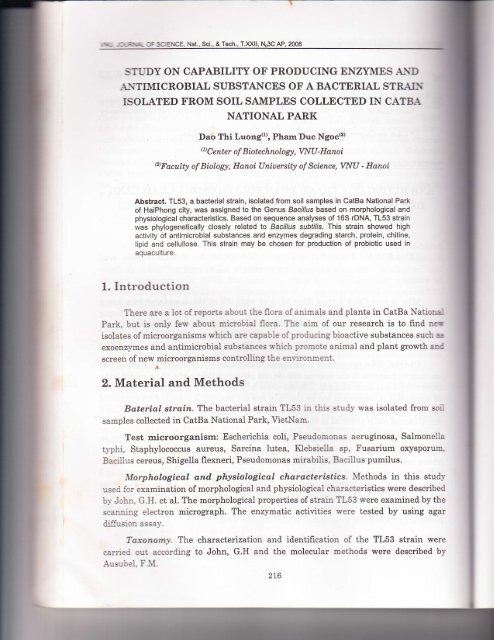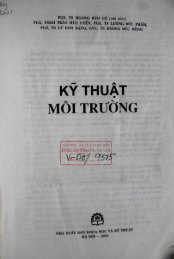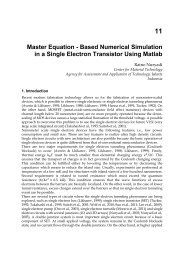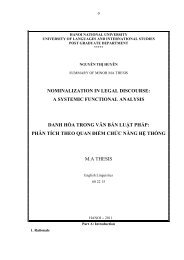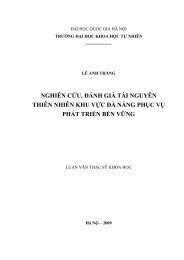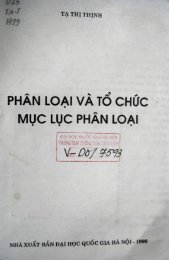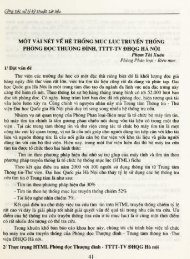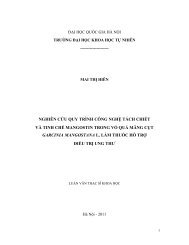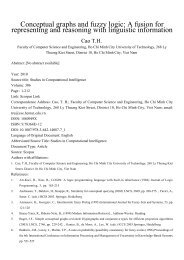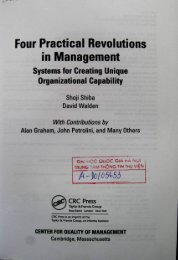1. Introduction
1. Introduction
1. Introduction
You also want an ePaper? Increase the reach of your titles
YUMPU automatically turns print PDFs into web optimized ePapers that Google loves.
lrfllL .B;F[iUrl- 3F SClErcE, Nat., Sci., & Tech., T)fi||, AP.2006<br />
ST:t.iDY ON CAPABILITY OF PRODUCING ENZYMES AND<br />
ANTIMICROBIAL SUBSTANCES OF A BACTERIAL STRADT.<br />
ISOLATED FROM SOIL SA]VIPLES COLLECTED IN CATBA<br />
NATIONAL PARK<br />
Dao Thi Luong(l), Pham Duc Ngoc(2)<br />
(1) C enter of Biotechnology, WU -Hanoi<br />
(DFaculty of Biology, Hanoi Uniuersity of Science, VNU - Hanoi<br />
Abstract. TL53, a bacterial strain, isolated from soil samples in CatBa National Park<br />
of HaiPhong city, was assigned to the Genus Bacillus based on morphological and<br />
physiological characteristics. Based on sequence analyses of 165 rDNA, TL53 strain<br />
was phylogenetically closely related lo Bacillus subf/r's. This strain showed high<br />
activity of antimicrobial substances and enzymes degrading starch, protein, chitine,<br />
lipid and cellullose. This strain may be chosen for production of probiotic used in<br />
aquaculture.<br />
<strong>1.</strong> <strong>Introduction</strong><br />
There are a lot of reports about the flora of animals and plants in CatBa Nationrl<br />
Park, but is only few about microbial flora. The aim of our research is to find ner<br />
isolates of microorganisms which are capable of producing bioactive substances such a,s<br />
exoenzymes and antimicrobial substances which promote animal and plant growth and<br />
screen of new<br />
s controllin g th e environm ent.<br />
^microorganism<br />
2. Material and Methods<br />
Baterial strain. The bacterial strain TL53 in this study was isolated from soil<br />
samples collected in CatBa National Park, VietNam'<br />
Test microorganism: Escherichia coli, Pseudomonas aeruginosa, Salmonella<br />
tlphi, Staphylococcus aureus, Sarcina lutea, Klebsiella sp, Fusarium oxysporum,<br />
Bacillus cereus, Shigella flexneri, Pseudomonas mirabilis, Bacillus pumilus.<br />
Morphological and, physiological charocteristics. Methods in this study<br />
used for examination of morphological and physiological characteristics were described<br />
by John. G.H. et al. The morphological properties of strain TL53 were examined by the<br />
scannixg electron micrograph. The enzymatic activities were tested by using agar<br />
diffusion assay.<br />
Toxonomy. The characterization and identification of the<br />
carried out according to John, G.H and the molecular methods<br />
Ausubel, F.I[.<br />
216<br />
TL53 strain were<br />
were described by
Study on capability of producing enzymes and... 2r7<br />
The 165 rDNA sequence of strain TL53 was determined after DNA amplified by<br />
using PCR. Then both strands of 165 rDNA obtained was sequenced directly by ABI<br />
3100 Avant sequencing machine of Perkin-Elmer (LISA). Generated sequences were<br />
aligned with related species by using Clustal W ver.<strong>1.</strong>83 software. Reference sequences<br />
used for phylogenetic study was obtained from the database of gene bank (http:<br />
//www.ncbi.nlm.nih.gov). The phylogenetic tree was constructed from the evolutionary<br />
distance data arcoding to Kimura (1990) usi-ng the neighbor-joining method (Saitou<br />
and Nei, 1987). Sites where gaps exsisted in any sequence were excluded. Bootstrap<br />
analysis (Felsenstein) were performed from 1000 random resampling. A11 of<br />
phylogenetic analyses were carried out using the PHYLIP package (Fe1senstein, 1993).<br />
3. Results and discussion<br />
Among 153 baterial strains with hydron5d.c actir.ity of organic compounds<br />
isolated from soil samples in CatBa Nationa-l Fark- TlL53 strain had highest activity of<br />
enzymes hydrolyzing starch, casein, CN{C, Tween 8O and chitiae.<br />
Cultural characteristics<br />
Mophorlogical, physiological characteristics of sm'ain TL5,il :<br />
The colonies of strain TL53 are round. The smeak cutrrure is pa-ne yellosrr, smooth<br />
and shining. Its vegetative cells are rod, produee endospores nr'''d are able ro motile.<br />
The results were shown at table 1:<br />
Tablel. Some of cultural and physiological properths o{ tt*r TUit<br />
Characters Characters<br />
Cultural orooerties Physiolog ical properties<br />
Aerial mass color Yellow Sunfate reductim<br />
Reverse side color Gray Catalase test +<br />
Diffuse pioment Oxidase test +<br />
Endosoore round Nitrate reduction<br />
Flaoella Fermentation product lactate<br />
Gram stain + Respiration type aerobic<br />
Motilitv<br />
Salt tolerarrce r!\aG 7Yo<br />
Determination of optirnal media<br />
+<br />
The strain. TT-13 was cultivated at 500C on a rotary shaker at 200 rpm for 48h in<br />
various medi.a: [i:::c::son-Cla11on, Fish eixtract, Fish extract-CMC, bean sprout<br />
extract, modifi.ed, red';-. After 48h, the cultural broth obtained was tested for<br />
activities of C}-[Case- '':p.a--.e- ii:J.nase, amylase by using the agar diffusion assay. The<br />
results were sieom: a: Te;-: -
Determination of optimal pH<br />
Table 2. Enrymatic activities of TL53 in difierent culture media<br />
Dao Thi Luong, Pham Duc<br />
Media FinalpH OD activities (D -d<br />
Amilase Chitinase Protease Lipase CMC-ase<br />
I 8.3 0.80 25 n 27 17 27<br />
2 7.5 0.82 27 24 30 15 29<br />
3 8.0 0.M 24 24 32 24 27<br />
4 7.7 0.85 n 26 30 20 26<br />
5 8.5 0.87 28 n 33 25 31<br />
The strain TL53 was incubated at at 500C on a shaker at 200 rpm for 48h in<br />
modified medium of nutrients broth. The pH is changed from 4 to 9. After 48h, the<br />
cultural broth obtained was tested for activities of CMC-ase, lipase, kitinase, amylase<br />
and protease by using the agar diffusion assay. The results were shown at Table 3.<br />
Table 3. The hfr.sre of *l m €nz1natic activities of TL53 strain<br />
lnitial pH Final pH oo Enzyrfles aciivities (D.d , mm)<br />
Amilase Chitinase Protease Lipase CMC-ase<br />
4 6.32 0.626 10 12 15 18 18<br />
5 8.13 0.742 25 u 26 18 29<br />
6 8.24 0.843 27 25 27 21 30<br />
7 8.30 0.950 29 29 32 25 33<br />
I 8.40 0.903 27 27 24 22 31<br />
I 8.00 0.800 24 25 20 22 28<br />
The results showed that pH range for the growth was relative large from S to 8.<br />
The pH of fermentation after culturing is relative constant. In suitable pH, the<br />
enzymatic activities and cell growth increased. The optimal pH was 7.<br />
Determination of optimal temperature<br />
The strain TL53 was incubated on a rotary shaker at 200 rpm for 48h at 200C,<br />
250C, 300C, 350C, 400C, 500C, 600C in modified medium. After 48h, the cultural broth<br />
obtained was tested for activities of CMC-ase, lipase, chitinase, amylase and protease<br />
by using agar diffusion assay and measured for pH and OD.The results were shown at<br />
Table 4<br />
Table 4. The influence of temperature on enrymatic activities and growth of TL53<br />
Temperatu - re Final pH OD<br />
Enrymes activities (D.d , mm)<br />
Amilase Chitinase Protease Lipase CMC-ase<br />
25 7.71 0.800 24 23 24 18 25
Study on capability ofproducing enzymes and'.. 219<br />
30 8.04 0.850 26 24 24 18 25<br />
35 8.15 0.890 26 27 31 23 28<br />
40 8.21 0.930 30 30 34 27 34<br />
45 8.2 0.860 28 27 30 25 31<br />
50 9.41 , 0.840 28 25 31 25 29<br />
55 7.36 0.780 20 19 t5 20 20<br />
60 7.17 0.560 10 12 10 13<br />
The results showed rhat srpein TL53 had a relative large temperature range. The<br />
enzymatic activities increased in directll' propotion to temperature.<br />
Determ.ination of oPtirnel tinne<br />
The strain TL53 was incubated at -lO:C on a rotary shaker at 200 rpm for 72h in<br />
modifred medium. Every 12h, the fermentation broth obtained was tested for CMC-ase,<br />
lipase, chitinase, amylase and protease by u*ing agar diffusion assay. The results were<br />
shows at Table 5<br />
Table 5. The influence of ttune on erffi* dftnb rtd grorrlrt of TUiil.<br />
Time (h) finalpH OD Enzyrres dfrEs (D { " rnrn)<br />
Amylase Chilinase ffiase [-pase CMC-ase<br />
12 7.71 0.550 25 22 n 16<br />
26<br />
24 8.08 0.870 28 28 30 30<br />
JO 8.20 0.910 28 29 31 31<br />
48 8.31 0.940 32 29 34 29<br />
33<br />
60 8.43 0.910 33 29 32 32<br />
72 8.03 0.860 29 27 28 23<br />
28<br />
The results showed that the enzymatic activities and growth of TI^53 increased<br />
relatively stabtr3- from 36 to 72h. However, after 48h of culture, the en-zymatic activities<br />
increased ontry slightly or even not at all'<br />
Antimicrpbial octiuity,r To determine the capability of producing antimicrobial<br />
substances, srrai.rl TI53 was cultivated on a rotary shaker (180 rpm) for 72}r, at 280C in<br />
modified medium of nut-rients broth. After 48h, the cultural fluid was centrifuged<br />
9000prm then the supernatant obtained was added to the wells on the agar plates<br />
which had been spread the test microorganism. The Petri dishes were placed in a<br />
refrigerator from 4-8h then were kept in a warm cup board. After 24h, the petri dishes<br />
were taken out to ohseme the diemeter of antimicrobial-zone. The results were shown<br />
at Table 5.<br />
n<br />
n<br />
a
Table 6. furtimkxobial activities against teshmicroorganism<br />
Test Microorqanisrlr Antimicrobial activities (D-d. mm)<br />
Pseudomonas minffik 17<br />
Sarcina lutea u<br />
Staphvlococcus aurets 17<br />
Salmonella tvohi<br />
K/ebsle//a so<br />
Fusaium orvsoonfiT 32<br />
P se u d omo n as aefl.rsdriloffi<br />
BacrTlus cererc<br />
Bacillus pu4.its<br />
Candida albmafts<br />
Eschendm cd 3<br />
Sequencing and phylogenetic an alysis<br />
The 16.5 rDNA sequence of TT,53 strain was determined after DNA amplifred by<br />
using PCB' Then both strand of 165 rDNA obtained was sequenced directly by ABI<br />
3100 Avant sequencing machine of Perkin-Elmer (USA). Generated sequences were<br />
aligned with related species by using Clustal W ver. <strong>1.</strong>74 program. Reference sequences<br />
used for phylogenetic study was obtained from the database of genebank<br />
(http ://www. ncbi.nlm.nih. gov)<br />
Bacillus thuingiensis<br />
Bacillus anthracis<br />
Bacillus cercus<br />
Bacillus flexus<br />
Bacillus megaterium<br />
Bacillus simplex<br />
Bacillus asahii<br />
Bacitlus munlis<br />
B aci I I u s psych rosacch arclyti c u<br />
Bacillus fimus<br />
looo r Bacillusidicus<br />
Bacillus cibi<br />
Bacillus pumilus<br />
700<br />
947<br />
Figure'<strong>1.</strong> The Phylogenetic tree of TL53 strain<br />
Bacillus atrophaeus<br />
B aci ll u s licheniformis<br />
Bacillus mojavensis<br />
Bacillus vallismortis<br />
Bacillus nematotocita<br />
TL53<br />
Bacillus subtilis<br />
B aci I I u s a m ylol ig u efacie n s<br />
rl<br />
T<br />
B<br />
t3<br />
t{<br />
TA<br />
s<br />
thi<br />
cd<br />
sir<br />
hir<br />
nel<br />
c6:<br />
phi
Study on capabiliry of producing enzymes and'.. 221<br />
After comparing srith 165 rDNAs which have published in gene bank we realized<br />
that the similarity between TL53 and Banillus subtilis is99,7%o. The phylogenetic tree<br />
was constructed based on 165r DNA of TL53 strain and related species of genera<br />
Bacillus.<br />
The results showed that the TL53 strain was located at the Bacillus subtilis<br />
clade.<br />
After comparing the morphological, physioloeical characteristics of TL53 with<br />
Bacillus subtilis we can confirm that TL53 strain is Bocillus subtilis.<br />
t1l<br />
121<br />
t3l<br />
t4l<br />
REFERENCF^S<br />
Asubel, F. M., Brent, R., Kingston, R.E., Mmre- D-D-, S€idman, J.G., Smith, J.A. and<br />
Struhl, K. (1999). Short protocols in molecular Hog5. 4th Ed. John Weiley & Sons, Inc.<br />
pp 13-50.<br />
John G.H., NoeI R.K., Peter H.A.S., James T*S., Stsxlef, T.\tr. (1994). Bergeys Manual of<br />
Detertninatiue Bacteriology, ninth Edition- Wiliiam r&mlhn+ pp 559'562.<br />
Phillipp Gerhardt (1994), Methods for General and Molenrler Bacteriolory, Am.erican<br />
Society for Microbiology, Washington, DC. pp 622$2tl-<br />
Reissig J. L., Strominger J.L. , aud kloi,r LF. (1955). A modifrnntiou colorimetric<br />
method for the estimation of N-acetylqmino sugarst J. BioI"CIIart g?35S9<br />
TAp CHi KHOAHgCDHQGHN, KHTN &CN, T.XXll, S53CPT., ffi<br />
NGHTEN CIIU KHA NANC SINH ENZYM VA CAC CNAT XNEXC<br />
srNH cria cHriNc vI KHUdN TLsB PHAN lAp ru cAc rvrAu oAt<br />
rHU DuoC ruwoN qu6c GIA cAr BA<br />
DAo Thi Lrldng(r), PhAm Dric Nggc(2)<br />
'"Tfung td,m C6ng nghQ Sinh hoc, Eq.i hpc Qudc gia Hd, NQi<br />
tuKhrlo Srnft ftoc, Trting Dq,i hgc Khoa h7c Tg nhiin, Dg,i hqc Qudc gia Hd Nfli<br />
TL5B Ie eh*oe ri khudn dtigc ph6n lap trl c6c mdu tldt & Vrrdn Qudc gia Cet Ba,<br />
thinh phdHii Phdng. Chring ndy c6 ho4t tfnh enzym m4nh phAn giii c6c hop chdt htu<br />
co nhrt tirrh bdc- prmen- Iipit, kitin, celluloz vh c6 hoat tfnh m4nh kh6ng c6c chtrng vi<br />
sinh vAt kidm r'?ir"t: Chu:g niy drrgc x6c dinh thu6c chi Bacillus dga tr6n c6c dac didm<br />
hinh thAi, sinh F rA &de tr€n r.i6c phAn tich trinh tg gen md h6a ARNr 165 thi chring<br />
ndy c6 m6i quan he cL,@ Icel ph.6t sinh gdn giri nhdt ddi v6i lodi Bacillus subtilis. Do<br />
c6 nhi6:u dq.c didm rrr. Tl€t c4..me nAy co thd dtrgc xem x6t tld srl dung trong chd tqo chd<br />
phdm probiotic dtne rrEEE =.:rdu" tir'g thtl' sAn.


